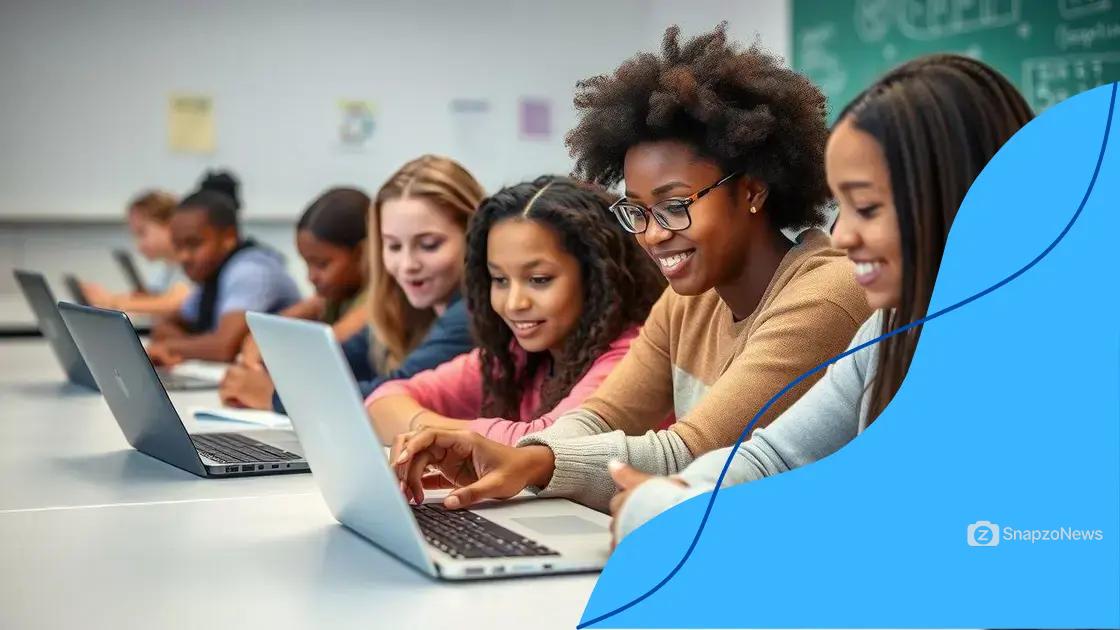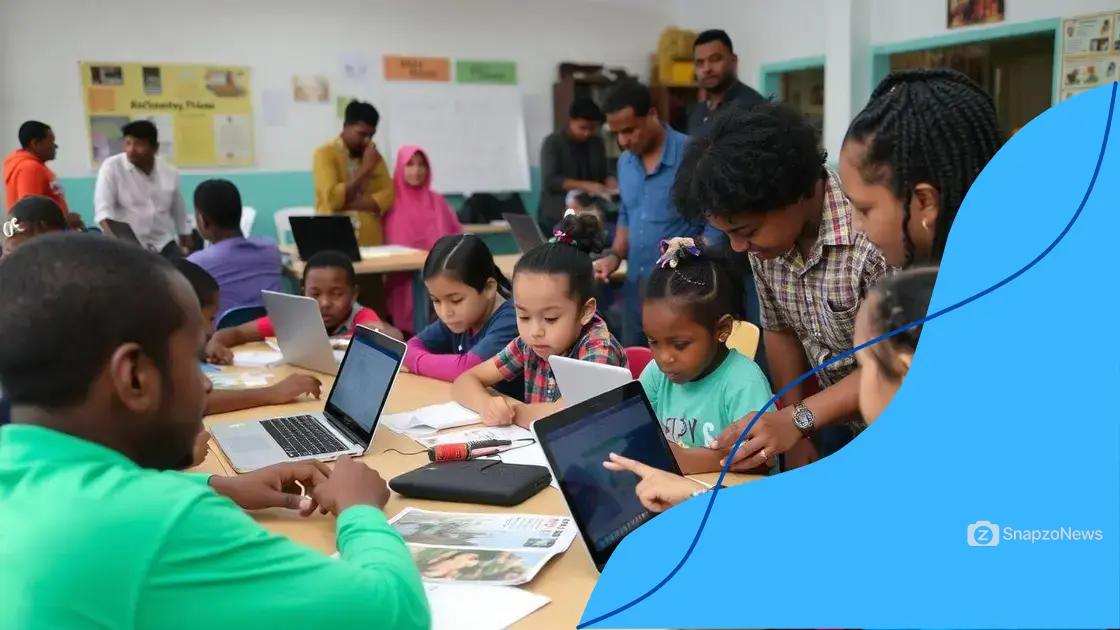Addressing the digital divide in education access

Addressing the digital divide in education access involves enhancing internet availability, providing devices, and fostering partnerships to ensure all students have equal opportunities to succeed in a technology-driven learning environment.
Addressing the digital divide in education access is essential for ensuring equality in learning opportunities. Have you ever considered how technology influences students’ chances to succeed? Let’s delve deeper.
Understanding the digital divide in education
Understanding the digital divide in education is a critical step toward ensuring all students have equal opportunities. The digital divide refers to the gap between those who have easy access to digital technology and those who do not, which can significantly affect educational outcomes.
What is the Digital Divide?
The digital divide affects students in various ways. It can stem from economic disparities, geographical location, and social factors. For instance, students in rural areas may lack access to high-speed internet, which limits their ability to research and complete assignments online.
Key Factors Contributing to the Digital Divide
- Socioeconomic status: Families with lower incomes may struggle to afford devices and internet access.
- Geographical disparities: Remote areas often have inadequate infrastructure for reliable internet access.
- Educational institutions: Schools in underfunded districts might lack the technology necessary for modern education.
An understanding of these factors is essential for addressing the issue. By acknowledging the challenges, educators and policymakers can work towards effective solutions. Increased efforts to provide affordable devices and broadband access can help level the playing field.
Furthermore, community programs can offer training to both students and parents on how to effectively use technology. These initiatives not only improve access but also empower families to utilize digital resources better, contributing positively to learning outcomes.
Conclusion: Bridging the Gap
To bridge this gap, it’s essential for government bodies, schools, and communities to collaborate. Ensuring that every child has access to the internet and devices creates a fairer educational environment for all.
Impact of technology on learning access
The impact of technology on learning access is profound. Technology has transformed how students interact with educational resources, making learning more accessible than ever before. With the right tools, students can explore topics, complete assignments, and collaborate effortlessly.
Benefits of Technology in Education
Integrating technology into the classroom provides numerous advantages. Students can engage with interactive content, which enhances their understanding of complex subjects. Moreover, technology often supports personalized learning experiences, allowing students to learn at their own pace.
- Increased engagement: Interactive tools can keep students interested and motivated.
- Access to diverse resources: Online platforms offer an array of materials beyond traditional textbooks.
- Collaboration opportunities: Students can work together on projects regardless of their physical location.
However, it is essential to recognize that not all students benefit equally from these advancements. Some may struggle with limited access to reliable technology, highlighting the importance of addressing the digital divide. Ensuring all students have access to necessary tools is vital for promoting equitable learning experiences.
Challenges of Technology Integration
Despite its benefits, integrating technology into education faces challenges. Teachers need adequate training to effectively implement new tools in their lessons. Additionally, ongoing technical support is crucial for sustaining the use of technology in classrooms. Schools must invest in infrastructure and professional development to create a seamless learning environment.
As technology evolves, so must our approach to education. Continuous adaptation to new technologies can bolster learning access for all students. With proper support and resources, technology can help bridge gaps and create a more inclusive educational landscape.
Strategies for bridging the gap

Strategies for bridging the gap in education are essential for ensuring all students have access to quality learning opportunities. These strategies aim to overcome the barriers created by the digital divide, allowing every child to thrive in an increasingly technology-driven world.
Enhancing Internet Access
One of the most effective strategies includes enhancing internet access for underserved communities. Providing affordable broadband services is vital for bridging this gap. Making internet access a public utility can ensure that all families have the connectivity they need for educational activities.
Providing Devices
Access to reliable devices is crucial. Schools and organizations can develop programs to supply students with laptops or tablets. Initiatives that recycle old devices can also provide necessary technology to students who lack resources.
- Device lending programs: Schools can create lending libraries for students who need technological assistance.
- Partnerships with tech companies: Collaboration with technology firms can help secure affordable devices.
- Incentives for families: Offering subsidies or discounts to low-income families can increase device ownership.
Educational content must also be adaptable for mobile devices, ensuring that all students can access learning materials, regardless of their device capabilities. Teacher training is another essential component of these strategies. Educators need proper training to effectively integrate technology into their teaching methods, which can help them assist students in navigating digital resources.
Community Engagement
Strong community engagement is vital for these strategies to succeed. Schools can organize workshops for parents and families, educating them on the tools available to support their children’s learning. Building partnerships with local businesses and nonprofits can also provide additional resources and support systems for students.
Furthermore, mentoring programs can be established to connect students with role models in the tech field, inspiring them and providing guidance on future educational paths. These strategies work together to create a more inclusive educational environment, ensuring that no child is left behind.
Role of government and organizations
The role of government and organizations in addressing the digital divide in education is crucial. They are key players in creating policies and programs that can provide equitable access to technology for all students. Without these efforts, many students would continue to face significant barriers in their learning.
Government Initiatives
Governments can implement various initiatives to improve technology access. They can allocate funding to support infrastructure development in underserved areas. This includes expanding broadband coverage to rural and low-income urban communities. Additionally, governments can offer tax incentives for companies that invest in technology for education.
Partnerships with Organizations
Partnerships between government bodies and non-profit organizations can amplify these efforts. Non-profits often have the grassroots connections necessary to reach the communities in need. Together, they can create tailored programs that provide devices, internet access, and digital literacy training.
- Digital literacy programs: Offering training sessions for students and parents can help bridge the knowledge gap.
- Device donation initiatives: Organizations can collect and distribute used devices to students who lack access.
- Policy advocacy: Working together, organizations can advocate for laws and policies that prioritize education technology access.
Moreover, government agencies can establish grants for schools to implement technology-enhanced curricula. By investing in professional development for teachers, they can ensure that educators are prepared to integrate technology into their teaching.
Monitoring Progress
It is important for governments and organizations to monitor the progress of their initiatives. Regular assessments can identify areas that need improvement and help adapt strategies to better meet the needs of students. Transparent reporting on outcomes fosters accountability and builds trust within communities.
Ultimately, the collaborative efforts of government and organizations can create a more equitable educational landscape. By prioritizing access to technology and investing in the necessary support systems, they can help close the digital divide for future generations.
Future trends in educational technology
Future trends in educational technology promise to reshape how learning occurs in classrooms. As technology advances, new tools and methods are emerging to enhance student engagement and success. Understanding these trends is essential for educators, students, and parents alike.
Artificial Intelligence in Education
One of the most exciting trends is the use of artificial intelligence (AI) in education. AI can personalize learning experiences by adapting to the needs and pace of each student. This means tailored recommendations for resources, helping students overcome challenges.
Virtual and Augmented Reality
Virtual reality (VR) and augmented reality (AR) are also gaining traction. These technologies offer immersive learning experiences that can transport students to different environments. For instance, history lessons can come alive through virtual field trips, making the learning process more engaging.
- Enhanced engagement: Students are more involved when learning through interactive technologies.
- Real-world applications: Using VR/AR can demonstrate real-world scenarios, making concepts easier to understand.
- Collaborative learning: Students can work together in virtual spaces regardless of their physical location.
Another significant trend is the increased focus on data analytics in education. Teachers can track student performance through data analytics, allowing them to identify areas where students are struggling. This data-driven approach enables personalized support, helping improve overall educational outcomes.
Gamification of Learning
Gamification is another effective strategy that incorporates game elements into learning. By earning rewards and completing challenges, students feel more motivated to learn and participate. This approach keeps students engaged and encourages a love for learning through fun and interactive experiences.
Additionally, mobile learning continues to grow as more students use smartphones and tablets. This trend allows learning to happen anytime and anywhere, making education more accessible. As students embrace mobile devices, educational resources must adapt to be mobile-friendly.
By staying informed about these trends, educators can prepare to implement innovative technologies that benefit their students. The future of education is bright, and the potential for integrating technology into learning is endless.
FAQ – Frequently Asked Questions about Addressing the Digital Divide in Education Access
What is the digital divide in education?
The digital divide refers to the gap between those who have easy access to technology and the internet and those who do not, affecting students’ learning opportunities.
How can governments help bridge the digital divide?
Governments can implement policies, provide funding for infrastructure, and support initiatives that ensure all students have access to technology and the internet.
What role do community organizations play in education access?
Community organizations can provide resources, support programs to distribute devices, and offer digital literacy training to help families navigate technology.
What future trends in educational technology should we be aware of?
Trends like artificial intelligence, virtual reality, and gamification are shaping how students learn and engage, making education more interactive and accessible.
